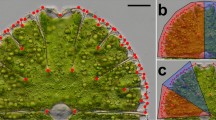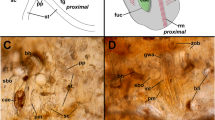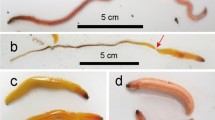Abstract
Zooid size variation and growth banding in the bryozoan Pentapora fascialis, collected from the South of Great Britain to the South of Italy, were investigated in order to test their relationship with the variation of seawater temperature. Zooid length appeared to be more sensitive than zooid area and width to temperature variation. The longest zooids were budded in localities that typically experience low seasonal variation in temperature (3.2–7.5°C) and low mean annual temperature (about 11°C). Zooid length demonstrated the strongest relationship with the range of seasonal variation in temperature rather than the mean annual temperature. Growth bands produced during colder months were less high than those produced during warmer months. Measurements of these alternating bands were used to calculate growth rate of the laminae, ranging from 20.7 at Plymouth to 29.3 mm year−1 at Tino Island. Significant differences in zooid length were found between the two bands, with longer zooids within the band developed in colder months and shorter zooids in bands produced in the warmer period. We conclude that zooid size can be used as an environmental proxy of the seasonal temperature regimes experienced by the species.




Similar content being viewed by others
References
Alvarez JA (1991) La collección de Briozoos del Museo Nacional de Ciencias Naturales. Monografias Mus Nac Ciencies Nat 5:1–188
Atkinson D (1994) Temperature and organism size—a biological law for ectotherms? Adv Ecol Res 25:1–57
Bader B, Schäfer P (2004) Skeletal morphogenesis and growth check lines in the Antarctic bryozoan Melicerita obliqua. J Nat Hist 38(22):2901–2922
Barnes DKA (1995) Seasonal and annual growth in erect species of Antarctic bryozoans. J Exp Mar Biol Ecol 188:181–198
Bassano E, Boniforti R, Pezzani A (1998) Parametri meteorologici e idrologici. In: Peroni C (ed) Sistema Informativo e di Monitoraggio Marino Costiero della Provincia di La Spezia. ENEA, Roma, pp 17–55
Cocito S, Ferdeghini F (1998) Marcatura con colorante ed etichettatura: due metodi per misurare la crescita in briozoi calcificati. In: Piccazzo M (ed) Atti 12° Congr Ass It Ocean Lim, Alassio, pp 351–358
Cocito S, Novosel M, Novosel A (2004) Carbonate bioformations around underwater springs in the north-eastern Adriatic Sea. Facies 50:13–17
Cocito S, Sgorbini S, Bianchi CN (1998) Aspects of the biology of the bryozoan Pentapora fascialis in the northwestern Mediterranean. Mar Biol 131:73–82
Eggleston D (1963) The marine Polyzoa of the Isle of Man. Thesis, University of Liverpool, pp 297
Garcia Lafuente J, Garcia A, Mazzola S, Quintanilla L, Delgado J, Cuttita A, Patti A (2002) Hydrographic phenomena influencing early life stages of the Sicilian Channel anchovy. Fish Oceanogr 11:31–44
Gautier YV (1962) Recherches écologiques sur les bryozoaires chilostomes en Méditerranée occidentale. Rec Trav Stat Mar Endoume 38(24):7–434
Hayward PJ, Ryland JS (1999) Cheilostomatous bryozoa, part 2: Hippothooidea–Celleporoidea. In: Barnes RSK, Crothers JH (eds) Synopses of the British Fauna (New Series). Field Studies Council, Shrewsbury, pp 1–416
Hunther E, Hughes RN (1994) The influence of temperature, food ratio and genotype on zooid size in Celleporella hyaline (L.). In: Hayward PJ, Ryland JS, Taylor PD (eds) Biology and palaeobiology of bryozoans. Olsen and Olsen, Fredensborg, pp 83–86
Jackson JBC, Herrera-Cubilla A (2000) Adaptation and constraint as determinants of zooid and ovicell size among encrusting Ascophoran Cheilostome Bryozoa from opposite sides of the isthmus of Panama. In: Herrera-Cubilla A, Jackson JBC (eds) Proceedings of 11th international bryozool associate conference, Smithsonian Tropical Res Inst, Panama, pp 249–258
Lidgard S (1985) Budding process and geometry in encrusting cheilostome bryozoans. In: Nielsen C, Larwood GP (eds) Bryozoa: ordovician to recent. Olsen and Olsen, Fredensborg, pp 175–182
McKinney FK, Jackson JBC (1989) Bryozoan evolution. Chicago University Press, Chicago
Menon NR (1972) Heat tolerance, growth and regeneration in the three North Sea bryozoans exposed to different constant temperatures. Mar Biol 15:1–11
Mustapha BK, Komatsu T, Hattour A, Sammari CH, Zarrouk S (2002) Bionomie des étages infra et circalittoral du golfe de Gabès. Bull Inst Nat Sci Tech Mer Salamb? 29:1–16
Novosel M, Požar-Domac A, Pasarić M (2004a) Diversity and distribution of the Bryozoa along underwater cliffs in the Adriatic Sea with special reference to thermal regime. PSZNI Mar Ecol 25(2):155–170
Novosel M, Olujic G, Cocito S, Požar-Domac A (2004b) Submarine freshwater springs: a unique habitat for the bryozoan Pentapora fascialis. In: Moyano U, Cancino, Wyse Jackson P (eds) Bryozoan studies. Taylor & Francis Group, London, pp 215–221
Occhipinti Ambrogi A, Ambrogi R (1987) Short-term changes in a brackish water assemblage of bryozoa with a particular reference to Conopeum seurati. In: Ross JRP (ed) Bryozoa: present and past. Western Washington University, Bellingham, pp 183–190
O’Dea A (2003) Seasonality and zooid size variation in Panamanian encrusting bryozoans. J Mar Biol Ass UK 83:1107–1108
O’Dea (2005) Zooid size parallels contemporaneous oxygen isotopes in a large colony of Pentapora foliacea (Bryozoa). Mar Biol 146(6):1075–1081
O’Dea A, Jackson JBC (2002) Bryozoan growth mirrors contrasting seasonal regimes across the Isthmus of Panama. Palaeogeogr Palaeocl Palaeoecol 185:77–94
O’Dea A, Okamura B (1999) Influence of seasonal variation in temperature, salinity and food availability on module size and colony growth of the estuarine bryozoan Conopeum seurati. Mar Biol 135:581–588
O’Dea A, Okamura B (2000) Intracolony variation in zooid size in cheilostome bryozoans as a new technique for investigating paleoseasonality. Palaeogeogr Palaeocl Palaeoecol 162:319–332
Okamura B (1985) The effects of ambient flow velocity, colony size, and upstream colonies on the feeding success of Bryozoa. Il Conopeum reticulum (Linnaeus), an encrusting species. J Exp Mar Biol Ecol 89:69–80
Okamura B (1987) Seasonal change in zooids size and feeding activity in epifaunal colonies of Electra pilosa. In: Ross JP (ed) Bryozoa: present and past. Western Washington University, Bellingham, pp 197–203
Okamura B, Bishop JDD (1988) Zooid size in cheilostome bryozoans as an indicator of relative paleotemperature. Palaeogeogr Palaeocl Palaeoecol 66:145–152
Pätzold J, Ristedt H, Wefer G (1987) Rate of growth and longevity of a large colony of Pentapora foliacea (Bryozoa) recorded in their oxygen isotopes profiles. Mar Biol 96: 535–538
Ryland JS (1963) The species of Haplopoma (Polizoa). Sarsia 10:8–18
Ryland JS, Porter JS (2005) Variation in zooid size in two west European species of Alcyonidium (Ctenostomatida). In: Moyano HI, Cancino JM, Wyse Jackson PN (eds) Bryozoan studies 2004. Balkema, London, pp 271–279
Southward A, Langmead O, Hardman-Mountford NJ, Aiken J, Boalch GT , Dando PR, Genner MJ, Joint I, Kendall MA, Halliday NC, Harris RP, Leaper R, Mieszkowska N, Pingree RD, Richardson AJ, Sims DW, Smith T, Walne AW, Hawkins SJ (2004) Long term oceanographic and ecological research in the western English Channel. Adv Mar Biol 47:1–105
Stebbing ARD (1971) Growth of Flustra foliacea (Bryozoa). Mar Biol 9:267–273
Zabala M, Maluquer P (1988) Illustrated keys for the classification of Mediterranean Bryozoa. Treb Mus Zool, Barcelona
Acknowledgements
We are grateful to S. Sgorbini, A. Peirano, P. Ritrovato, M. Novosel, R. Sandulli who assisted with field sampling. G.M.R. Manzella, F. Reseghetti, A. Bordone, A. Schirone, G. Gasparini, NJ Hardman-Mountford, A. Southward for temperature data, M. Abbate for microscope analysis, F. Provera for data analysis. A. O’Dea and one anonymous reviewer provided valuable comments and suggestions that greatly improved the ms.
Author information
Authors and Affiliations
Corresponding author
Additional information
Communicated by R. Cattaneo-Vietti, Genova
Rights and permissions
About this article
Cite this article
Lombardi, C., Cocito, S., Occhipinti-Ambrogi, A. et al. The influence of seawater temperature on zooid size and growth rate in Pentapora fascialis (Bryozoa: Cheilostomata). Mar Biol 149, 1103–1109 (2006). https://doi.org/10.1007/s00227-006-0295-3
Received:
Accepted:
Published:
Issue Date:
DOI: https://doi.org/10.1007/s00227-006-0295-3




